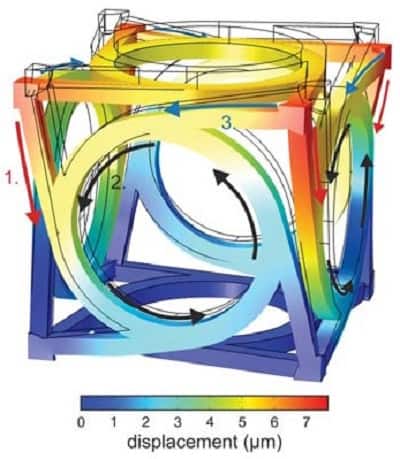
A rationally designed metamaterial that twists in response to a linear force has been engineered by researchers at Karlsruhe Institute of Technology, Germany, and Université de Bourgogne Franche-Comté, France. The material consists of a repeating array of sub-millimetre units, each of which has a chiral structure.
In ordinary continuum mechanics, twisting motions never result from simple linear forces. Instead, squeezing an elastic object always causes it to expand at right angles to the direction of compression. By using precisely structured cells as the constituents, however, Tobias Frenzel and colleagues created a metamaterial crystal that can respond to pressure by deforming rotationally at a rate of more than 2° per % of shortening.
The researchers used numerical modelling to decide on a cubic form for the unit cells, and then demonstrated the configuration physically in a 3D-laser-printed polymer structure. When a given cell is compressed, rings in each face of the cube are made to rotate, pulling the corners of each cell around with them.
Frenzel and his team found that using a greater number of smaller cells – while keeping the overall size of the sample constant – caused the stiffness of the structure to increase and the twisting effect to diminish. This contrasts with the behaviour expected in classical continuum mechanics, in which rotational strain would be forbidden, and stiffness would be scale-independent.
The design of materials with custom elastic behaviour could allow engineers to create mechanical analogues of optical metamaterials. One potential application suggested by the researchers is the construction of passive or active structures to steer force fields or mechanical waves around obstacles.
The research is published in Science.



